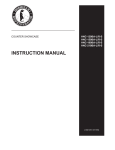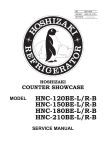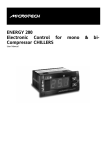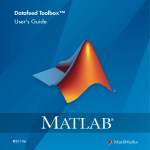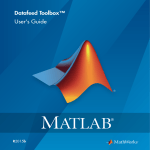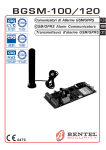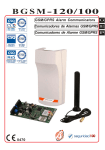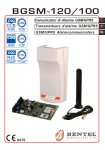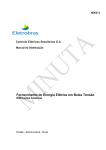Download Service Manual
Transcript
NO. S041-789 ISSUED: OCT. 26, 2009 REVISED: JAN. 28, 2014 HOSHIZAKI COUNTER SHOWCASE MODEL HNC-120BA-L/R-S HNC-150BA-L/R-S HNC-180BA-L/R-S HNC-210BA-L/R-S SERVICE MANUAL IMPORTANT Only qualified service technicians should install, service or maintain the product. No service or maintenance should be undertaken until the technician has thoroughly read this Service Manual. Failure to service and maintain the equipment in accordance with this manual may adversely affect safety, performance, and warranty coverage. Hoshizaki provides this manual primarily to assist qualified service technicians in the maintenance and service of the product. Should the reader have any questions or concerns which have not been satisfactorily addressed, please call, write, or send an e-mail message to the Hoshizaki Technical Support Department for assistance. HOSHIZAKI AMERICA, INC. 618 Highway 74 South Peachtree City, GA 30269 Attn: Hoshizaki Technical Support Department Phone: 1-800-233-1940 Technical Support (770) 487-2331 Fax: 1-800-843-1056 (770) 487-3360 E-mail: [email protected] Web Site: www.hoshizaki.com NOTE: To expedite assistance, all correspondence/communication MUST include the following information: • Model Number • Serial Number • Complete and detailed explanation of the problem. IMPORTANT This manual should be read carefully before the showcase is serviced or maintenance operations are performed. Only qualified service technicians should install, service, and maintain the showcase. Read the warnings contained in this booklet carefully as they give important information regarding safety. Please retain this booklet for any further reference that may be necessary. CONTENTS PAGE 1. SAFETY INSTRUCTIONS ---------------------------------------------------------------------------- 1 2. MODEL NAME ------------------------------------------------------------------------------------------- 3 3. OPERATING INSTRUCTIONS ---------------------------------------------------------------------- 4 4. SPECIFICATIONS -------------------------------------------------------------------------------------- 5 5. DIMENSIONS -------------------------------------------------------------------------------------------- 7 [a] HNC-120BA-L-S ------------------------------------------------------------------------------------ 7 [b] HNC-120BA-R-S ------------------------------------------------------------------------------------ 8 [c] HNC-150BA-L-S ------------------------------------------------------------------------------------ 9 [d] HNC-150BA-R-S ---------------------------------------------------------------------------------- 10 [e] HNC-180BA-L-S -----------------------------------------------------------------------------------11 [f] HNC-180BA-R-S ---------------------------------------------------------------------------------- 12 [g] HNC-210BA-L-S ---------------------------------------------------------------------------------- 13 [h] HNC-210BA-R-S ---------------------------------------------------------------------------------- 14 6. REFRIGERATION CIRCUIT ----------------------------------------------------------------------- 15 7. WIRING DIAGRAM ----------------------------------------------------------------------------------- 16 8. CONSTRUCTION------------------------------------------------------------------------------------- 18 9. REMOVAL AND REPLACEMENT ---------------------------------------------------------------- 19 [a] SIDE COVER -------------------------------------------------------------------------------------- 19 [b] TOP COVER --------------------------------------------------------------------------------------- 19 [c] FRONT GLASS ----------------------------------------------------------------------------------- 19 [d] SIDE FRAME -------------------------------------------------------------------------------------- 20 [e] CENTER FRAME --------------------------------------------------------------------------------- 20 [f] HOLDER - EVAPORATOR PIPE ------------------------------------------------------------- 20 [g] UNIT ------------------------------------------------------------------------------------------------- 20 10. REFRIGERANT SERVICE INFORMATION --------------------------------------------------- 21 i 11. CONSTANT PRESSURE EXPANSION VALVE AND REFRIGERANT CHARGE ---- 22 [a] SPECIFICATIONS-------------------------------------------------------------------------------- 22 [b] FUNCTION ----------------------------------------------------------------------------------------- 22 [c] CONSTRUCTION -------------------------------------------------------------------------------- 22 [d] REPLACEMENT ---------------------------------------------------------------------------------- 23 12. SERVICE DIAGNOSIS ------------------------------------------------------------------------------ 24 ii 1. SAFETY INSTRUCTIONS The following instructions contain important safety precautions and should be strictly REVHUYHG7KHWHUPVXVHGKHUHDUHGH¿QHGDVIROORZV WARNING 7KHUHLVDSRVVLELOLW\RIGHDWKRUVHULRXVLQMXU\IRUWKHVHUYLFHSHUVRQDQG a third party or the user due to improper service operations or defects in serviced products. CAUTION 7KHUHLVDSRVVLELOLW\RILQMXU\IRUWKHVHUYLFHSHUVRQDQGDWKLUGSDUW\RUWKH user or damage to their property* due to improper service operations or defects in serviced products. * The term “damage to their property” here refers to extensive damage to household effects, houses and pets. WARNING $OZD\VDVNWKHXVHUWRNHHSFKLOGUHQDZD\IURPWKHZRUNDUHD7KH\PD\EHLQMXUHGE\ tools or disassembled products. 2. When there is no need to energize the unit during disassembly or cleaning, be sure to unplug the unit or disconnect the main power supply before servicing the unit to prevent electric shocks. 3. If the unit must be energized for inspection of the electric circuit, use rubber gloves to avoid contact with any live parts resulting in electric shocks. .HHSWKHIROORZLQJLQPLQGZKHQVHUYLFLQJWKHUHIULJHUDWLRQFLUFXLW (1) Be sure to recover the refrigerant. Do not discharge it into the atmosphere. It will affect the environment. &KHFNIRUDQ\ÀDPHVLQWKHYLFLQLW\DQGHQVXUHJRRGYHQWLODWLRQ ,IWKHUHIULJHUDQWVKRXOGOHDNLQVHUYLFLQJLPPHGLDWHO\SXWRXWDQ\¿UHXVHGLQWKH vicinity. (4) When unbrazing the refrigeration circuit connections, check that the circuit is completely evacuated. The refrigerant may produce a poisonous gas when coming LQFRQWDFWZLWKDQRSHQÀDPH (5) Do not braze in an enclosed room to prevent carbon monoxide poisoning. (6) In case of a refrigerant leak, locate and repair the leaking part completely. Leaked refrigerant may produce a poisonous gas when coming in contact with an open ÀDPH 1 (7) Before servicing, check the surface temperature of the refrigeration circuit to prevent a burn. .HHSWKHIROORZLQJLQPLQGZKHQPDNLQJHOHFWULFDOFRQQHFWLRQV (1) Check for proper grounding connections, and repair if necessary to prevent electric shocks. (2) Always use service parts intended for the applicable model for replacement of defective parts. Use proper tools to secure the wiring. Otherwise abnormal RSHUDWLRQRUWURXEOHPD\RFFXUDQGFDXVHHOHFWULFOHDNVRU¿UH (3) Check for proper part installations, wiring conditions and soldered or solderless WHUPLQDOFRQQHFWLRQVWRDYRLG¿UHKHDWRUHOHFWULFVKRFNV (4) Be sure to replace damaged or deteriorated power cords and lead wires to prevent ¿UHKHDWRUHOHFWULFVKRFNV (5) Cut-off lead wires must be bound using closed end connectors or the like, with their closed ends up to avoid entrance of moisture that could lead to electric leaks or ¿UH (6) After servicing, always use a megohmmeter (500V DC) to check for the insulation resistance of at least 1 megohm between the live part (attachment plug) and the dead metal part (grounding terminal). (7) Do not service the electrical parts with wet hands to prevent electric shocks. (8) The capacitors used for the compressor and other components may be under high voltage and should be discharged properly before servicing. CAUTION $IWHUVHUYLFLQJIROORZWKHLQVWUXFWLRQVEHORZ (1) Check for water leaks in the water supply and drain pipes to prevent damage to the vicinity including household effects. $OZD\VFKHFNWKHXQLWIRUSURSHURSHUDWLRQEHIRUH¿QLVKLQJVHUYLFHV (3) Be sure to reassemble the parts completely. Loose assembly of such parts as control box cover may cause entrance of vermins resulting in a short circuit between terminals and possible ignition. 2 2. MODEL NAME H NC - 120 B A - L/R - S High Grade Counter Showcase Exterior 66WDLQOHVVVWHHO :LGWKFP Unit Location /8QLWRQOHIW 58QLWRQULJKW Development Order Starts from A HA model Unit on right Unit on left 3 3. OPERATING INSTRUCTIONS IMPORTANT Hoshizaki Counter Showcase is intended for temporary food display. &RQVWUXFWHGZLWKPXFKJODVVWKLVVKRZFDVHJLYHVUHODWLYHO\LQVXI¿FLHQWKHDW insulation and poor cooling performance compared with refrigerators in general. )RUVDIHDQGHI¿FLHQWRSHUDWLRQEHVXUHWRIROORZWKHLQVWUXFWLRQVEHORZ 1) Do not leave foods in the showcase after service hours, or they may dry or spoil. Foods WKDWVKRXOGQRWGU\PXVWEHFRYHUHGRUZUDSSHGXSLQDSODVWLF¿OP 2) Store only pre-refrigerated items in the showcase. It takes longer for foods to cool in the showcase than in a refrigerator. 3) Do not leave the doors open or open them too frequently. The interior temperature may rise, resulting in food deterioration. 4) Do not pack the showcase with foods. The cooling performance may reduce, resulting in food deterioration. 5) The showcase should not be exposed to direct sunlight or located next to ovens, grills or other high heat producing equipment. The interior temperature may rise, resulting in food deterioration. 6) The ambient temperature should not exceed 80°F (27°C). The cooling performance may reduce, resulting in food deterioration. 7) The food mount can be used on either side. The food temperature is controllable by turning over the food mount to change the distance from the interior bottom. Normal condition When food temperature is too low For more intensive cooling 8) The maximum safe height for displaying food products is 3.5” (9 cm) above the interior bottom. Food products should not be placed above this height as they may not remain cold enough to avoid spoilage. 4 4. SPECIFICATIONS Auxiliary code: C0 or earlier MODEL PRODUCT CODE AC SUPPLY VOLTAGE POWER SUPPLY CAPACITY RATED AMPERAGE STARTING AMPERAGE ELECTRIC CONSUMPTION POWER FACTOR PULL DOWN TIME (10°C) SATURATION TEMPERATURE NET CAPACITY EXTERIOR DIMENSIONS HNC-120BA-L-S HNC-150BA-L-S HNC-180BA-L-S HNC-210BA-L-S -R-S -R-S -R-S -R-S L: S041 L: S043 L: S045 L: S047 R: S042 R: S044 R: S046 R: S048 1 Phase 115V 60Hz 0.47kVA (4.7A) 3.2A 13A 195W 56% Approx. 30 min.(Ambient Temp. 27°C, No Load) Measured 20 mm above the food mount(normal position) Approx. 4°C(Ambient Temp. 27°C, No Load) located at the interior bottom center 42 L 1200 mm (W) (D) 345 mm (H) 270 mm 57 L 1500 mm 72 L 1800 mm 87 L 2100 mm 845 mm 1145 mm 1445 mm 1745 mm (W) (D) 288 mm (bottom) (H) 157 mm Glass, ABS Plastic, PVC Plastic, Stainless Steel EXTERIOR Glass, ABS Plastic, Stainless Steel INTERIOR Polyurethane Foam INSULATION L㸸D04762 L㸸D04764 L㸸D04766 L㸸D04768 DRAWING NO. (DIMENSIONS) R㸸D04763 R㸸D04765 R㸸D04767 R㸸D04769 REFRIGERATION SYSTEM Convection Cooling DEFROST SYSTEM None COMPRESSOR Hermetic 130W Model CE56Y-1ZU CONDENSER Fin and Tube Type, Cooling Fan Motor x 1 EVAPORATOR (UPPER) Bare Tube Type, (LOWER) Pipe on Sheet Type REFRIGERANT CONTROL Constant Pressure Expansion Valve REFRIGERANT TYPE / CHARGE R134a / 110 g R134a / 130 g R134a / 160 g R134a / 180 g ELECTRIC CIRCUIT PROTECTION Ground Fault Circuit Interrupter, Ground Wire COMPRESSOR PROTECTION Motor Protector SLIDING DOOR 2 pcs. 4 pcs. NET WEIGHT / GROSS WEIGHT 32 kg / 39 kg 37 kg / 46 kg 42 kg / 53 kg 47 kg / 60 kg PACKAGE Carton SHIPPING DIMENSIONS (W) 1300 mm 1600 mm 1900 mm 2200 mm (D) 430 mm (H) 473 mm CERTIFICATION To be NSF and UL certified 3 pcs. 4 pcs. 5 pcs. 6 pcs. ACCESSORIES FOOD MOUNT VINYL HOSE 1 pc. JOINT 2 pcs. AMBIENT TEMP. 10 - 27°C VOLTAGE VARIATION Rated voltage ±10% * The electrical specifications were determined at an ambient temperature of 27°C according to the electrical appliance technical standards. * The food temperature is controllable by turning over the food mounts. INTERIOR DIMENSIONS 5 Auxiliary code: C1 or later MODEL PRODUCT CODE AC SUPPLY VOLTAGE POWER SUPPLY CAPACITY RATED AMPERAGE STARTING AMPERAGE ELECTRIC CONSUMPTION POWER FACTOR PULL DOWN TIME (10°C) SATURATION TEMPERATURE NET CAPACITY EXTERIOR DIMENSIONS INTERIOR DIMENSIONS (W) (D) (H) (W) (D) (H) EXTERIOR INTERIOR INSULATION DRAWING NO. (DIMENSIONS) REFRIGERATION SYSTEM DEFROST SYSTEM COMPRESSOR CONDENSER EVAPORATOR REFRIGERANT CONTROL REFRIGERANT TYPE / CHARGE ELECTRIC CIRCUIT PROTECTION COMPRESSOR PROTECTION SLIDING DOOR NET WEIGHT / GROSS WEIGHT PACKAGE SHIPPING DIMENSIONS (W) (D) (H) CERTIFICATION ACCESSORIES FOOD MOUNT VINYL HOSE JOINT AMBIENT TEMP. VOLTAGE VARIATION HNC-120BA-L-S HNC-150BA-L-S HNC-180BA-L-S HNC-210BA-L-S -R-S -R-S -R-S -R-S L: s041 L: s043 L: s045 L: s041 R: S042 R: s044 R: s046 R: s042 1 Phase 115V 60Hz 0.44kVA (3.9A) 2.4A 15A 175W 63% Approx. 30 min. (Ambient Temp. 27°C, No Load) Measured 20mm above Approx. 4°C (Ambient Temp. 27°C, No Load) the food mount (normal position) located at the interior bottom center 42 L 57 L 72 L 87 L 1200 mm 1500 mm 1800 mm 2100 mm 345 mm 270 mm 845 mm 1145 mm 1445 mm 1745 mm 288 mm (bottom) 157 mm Glass, ABS Plastic, PVC Plastic, Stainless Steel Glass, ABS Plastic, Stainless Steel Polyurethane Foam L: D04762 L: D04764 L: D04766 L: D04768 R: D04763 R: D04765 R: D04767 R: D04769 Convection Cooling None Hermetic 110W Model FL1152-PD Fin and Tube Type, Cooling Fan Motor x 1 (UPPER) Bare Tube Type, (LOWER) Pipe on Sheet Type Constant Pressure Expansion Valve R134a / 95 g R134a / 115 g R134a / 145 g R134a / 165 g Ground Fault Circuit Interrupter, Ground Wire Motor Protector 2 pcs. 4 pcs. 35 kg / 42 kg 40 kg / 49 kg 45 kg / 56 kg 50 kg / 63 kg Carton 1300 mm 1600 mm 1900 mm 2200 mm 430mm 473 mm To be NSF and UL certified 3 pcs. 4 pcs. 5 pcs. 6 pcs. 1 pc. 2 pcs. 10 - 27°C Rated voltage ±10% * The electrical specifications were determined at an ambient temperature of 27°C according to the electrical appliance technical standards. * The food temperature is controllable by turning over the food mounts. 6 5. DIMENSIONS [a] HNC-120BA-L-S 7 [b] HNC-120BA-R-S 8 [c] HNC-150BA-L-S 9 [d] HNC-150BA-R-S 10 [e] HNC-180BA-L-S 11 [f] HNC-180BA-R-S 12 [g] HNC-210BA-L-S 13 [h] HNC-210BA-R-S 14 6. REFRIGERATION CIRCUIT Expansion Valve Drier Evaporator (Upper) Fan Motor Condenser Evaporator (Lower) Compressor Heat Exchange 5HIULJHUDQW5D 15 7. WIRING DIAGRAM Auxiliary code: C0 or earlier Power Supply 1 phase 115V 60Hz BK W BK W BU CM SR SC OL FM ELB Compressor Start Relay Start Capacitor Overload Relay Fan Motor Ground Fault Circuit Interrupter 16 Auxiliary code: C1 or later BK W Power Suppy 1 phase 115V 60Hz 2QYGT5WRRN[RJCUG8*\ BK 㧮㧷 W 㨃 GR / Y 㧳㧾㧛㨅 BK 㧮㧷 BU W 㨃 BU 㧮㨁 CM SR SC OL FM ELB Compressor Start Relay Start Capacitor Overload Relay Fan Motor Ground Fault Circuit Interrupter 17 8. CONSTRUCTION Top Cover Nameplate Front Glass Joint Plug Power Switch (Ground Fault Interrupter) Condenser Center Frame Air Filter Slider Louver Sliding Glass Door Food Mount 18 Hose 9. REMOVAL AND REPLACEMENT CAUTION 1. Be sure to unplug the showcase before removing or replacing the parts. 2. Handle the glass parts with care. [a] SIDE COVER Remove the two machine screws at the bottom, lift up the side cover, and unhook the top. [b] TOP COVER Top Cover Top Frame Remove the sliding door and side cover. 7KHWRSFRYHULVKRRNHGDQG¿[HGRQWKH top frame (aluminum). 2) Lift up and unhook the rear end of the top cover. 3) When the rear part is lifted off, move it forward to unhook and remove the front part. The top cover is tightly hooked on the top frame and will not come off easily. Remove it ZLWKFDUHWRDYRLGLQMXU\7RUHSODFHUHYHUVH the removal procedure. Fig. 1 [c] FRONT GLASS Remove the sliding door, side cover and top FRYHU/LIWWKHIURQWJODVVRIIWKHERWWRP¿W The bottom and side interior of the front glass is sealed with silicone sealant (black). Be sure to re-seal it at replacement. Top Frame Front Glass Fig. 2 19 [d] SIDE FRAME Remove the sliding door, side cover and top cover. Unbind the wiring on the side frame. Remove the two screws securing the top frame and the top of the side frame. Lift the side IUDPHRIIWKHERWWRP¿W [e] CENTER FRAME (Except HNC-120 type) Remove the two flat head machine screws (black) securing the center frame to the rear and the two machine screws securing the center frame to the top frame. Tilt the center IUDPHDQGUHOHDVHLWIURPWKH¿W Fig. 3 [f] HOLDER - EVAPORATOR PIPE Holder Evaporator Pipe Remove the truss head tapping screw (4 x 25) from the bottom of the top frame. Take off the center frame. Be careful with the evaporator pipe. It will be released and hang down. Remove the truss head tapping screw (4 x 10) from the bottom of the top frame. Truss Head Tapping Screw 4 x 25 Evaporator Pipe Truss Head Tapping Screw 4 x 10 Fig. 4 Outlet Pipe Expansion Valve [g] UNIT Remove the sliding door, side cover, top cover, top frame and side frame. Take off the compressor terminal cover and remove the starter and motor protector. Uninsulate the expansion valve and unbraze the outlet pipe with a gas burner (see “11. CONSTANT P R E S S U R E E X PA N S I O N VA LV E A N D REFRIGERANT CHARGE”). 8QEUD]H WKH MRLQW LQGLFDWHG 5HPRYH WKH IRXU machine screws securing the unit base. The whole unit can be pulled out. Joint Fig. 5 20 10. REFRIGERANT SERVICE INFORMATION 1) Allowable Compressor Opening Time and Prevention of Lubricant Mixture [R134a] The compressor must not be opened more than 30 minutes in replacement or service. Do not mix lubricants of different compressors even if both are charged with R134a, except when they uses the same lubricant. 2) Treatment for Refrigerant Leak [R134a] If a refrigerant leak occurs in the low side of a showcase charged with R134a, air may be drawn in. Even if the low side pressure is higher than the atmospheric pressure in normal operation, a continuous refrigerant leak will eventually lower the low side pressure below the atmospheric pressure and will cause air suction. Air contains a large amount of moisture, and ester easily absorbs a lot of moisture. If a showcase charged with R134a has possibly drawn in air, the drier must be replaced. Be sure to use a drier designed for R134a. 3) Handling of Handy Flux [R134a] 5HSDLURIWKHUHIULJHUDQWFLUFXLWQHHGVEUD]LQJ,WLVQRSUREOHPWRXVHWKHVDPHKDQG\ÀX[ that has been used for the current refrigerants. However, its entrance into the refrigerant circuit should be avoided as much as possible. 4) Oil for Processing of Copper Tubing [R134a] When processing the copper tubing for service, wipe off oil, if any used, by using alcohol or the like. Do not use too much oil and let it into the tubing, or wax contained in the oil will clog the capillary tubing. 5) Service Parts for R134a Some parts used for refrigerants other than R134a are similar to those for R134a. But QHYHUXVHDQ\SDUWVXQOHVVWKH\DUHVSHFL¿HGIRU5DEHFDXVHWKHLUHQGXUDQFHDJDLQVW the refrigerant have not been evaluated. Also, for R134a, do not use any parts that have been used for other refrigerants. Otherwise, wax and chlorine remaining on the parts may adversely affect R134a. 6) Replacement Copper Tubing [R134a] The copper tubes currently in use are available for R134a. But do not use them if oily inside. The residual oil in copper tubes should be as little as possible. (Low residual oil type copper tubes are used in the shipped units.) 7) Evacuation, Vacuum Pump and Refrigerant Charge [R134a] 1HYHUDOORZWKHRLOLQWKHYDFXXPSXPSWRÀRZEDFNZDUG7KHYDFXXPOHYHODQGYDFXXP pump may be the same as those for the current refrigerants. However, the rubber hose 21 and gauge manifold to be used for evacuation and refrigerant charge should be exclusively for R134a. 8) Refrigerant Leak Check Refrigerant leaks can be detected by charging the unit with a little refrigerant, raising the pressure with nitrogen and using an electric detector. Do not use air or oxygen instead of nitrogen for this purpose, or rise in pressure as well as in temperature may cause R134a to suddenly react with oxygen and explode. Be sure to use nitrogen to prevent explosion. 11. CONSTANT PRESSURE EXPANSION VALVE AND REFRIGERANT CHARGE [a] SPECIFICATIONS 0RGHO 0DQXIDFWXUHU 3DUW1XPEHU 5HIULJHUDQW $GMXVWPHQW5DQJH 3UHVVXUH5LVHE\$GMXVWLQJ6FUHZ +<34+' )XML.RNL 5D 03D 03DWXUQ [b] FUNCTION When the low side pressure drops, the Constant Pressure Expansion Valve opens and lets WKHUHIULJHUDQWÀRZWRNHHSDFRQVWDQWSUHVVXUH [c] CONSTRUCTION IN (High Pressure) $GMXVWLQJ Screw Cap Needle Valve OUT (Low Pressure) Close Open DOWN UP Low Pressure Working Bar $GMXVWLQJ Spring Diaphragm Fig. 6 22 Inner Spring [d] REPLACEMENT WARNING Always protect the valve body by using a damp cloth to prevent the valve from overheating. Do not braze with the valve body exceeding 230°F (110°C). IMPORTANT Always install a new Drier every time the sealed refrigeration system is opened. Do not replace the Drier until after all other repairs or replacement have been made. 1) Recover the refrigerant (R134a) and store it in an approved container. 2) Remove the Insulation Cover and Cap from the Expansion Valve. 3) Remove the Expansion Valve by heating the Inlet and Outlet Pipes with a gas burner. Wet Cloth Evaporator Burner Burner Drier Fig. 7 23 12. SERVICE DIAGNOSIS PROBLEM POSSIBLE CAUSE [1] Showcase will not 1. Ground fault circuit interrupter in start. OFF position. 2. Unplugged. 3. Supply voltage too low. [2] Poor cooling performance [3] Dry foods [4] Frosting REMEDEY 1. Turn ON. 2. Plug in. 3. Plug into a separate receptacle of 115V ± 10%. 4. No power supply to the wall outlet. 4. Correct. (Breaker or fuse blown out.) 5. Electrical circuit open or bad 5. Correct. contacts. 6. Motor protector tripped. 6. Ventilate and reset fan motor. 1. Gas leaks. 1. Repair the leaks and recharge. 2. Fan motor defective. 2. Replace. &RQGHQVHUDQGRUDLU¿OWHUFORJJHG 3. Clean. 4. Condenser air inlet blocked. 4 - 9. Instruct the user on characteristics and proper use 5. Exposed to direct sunlight. of the showcase. 6. Located next to a high heat producing equipment. 7. Doors opened too frequently or left open. 8. Packed with foods, or warm or hot foods inside. 9. Ambient temperature exceeding 80 °F (27°C). 1. Foods have been stored from the 1 - 2. Instruct the user on previous day. characteristics and proper use of the showcase. 2. Foods have been stored for a long time. 1. [Exterior] Relative humidity 1 - 2. Instruct the user on exceeding 60%. characteristics and proper use of the showcase. Wipe off 2. [Interior] Doors opened too excessive frost with a soft cloth. frequently or left open. 24




























